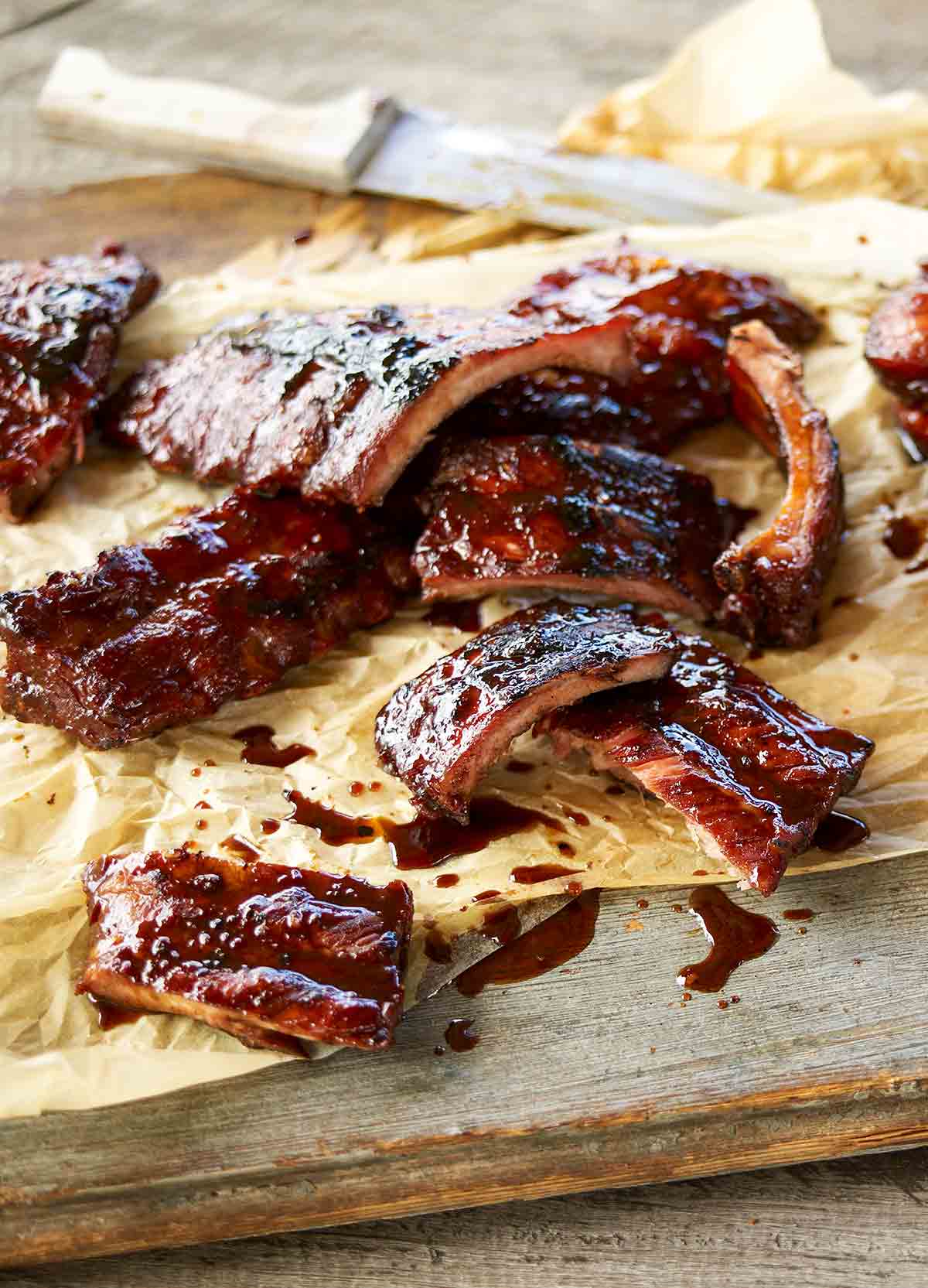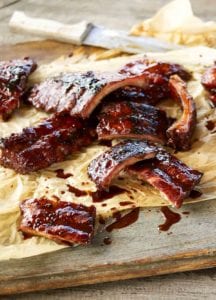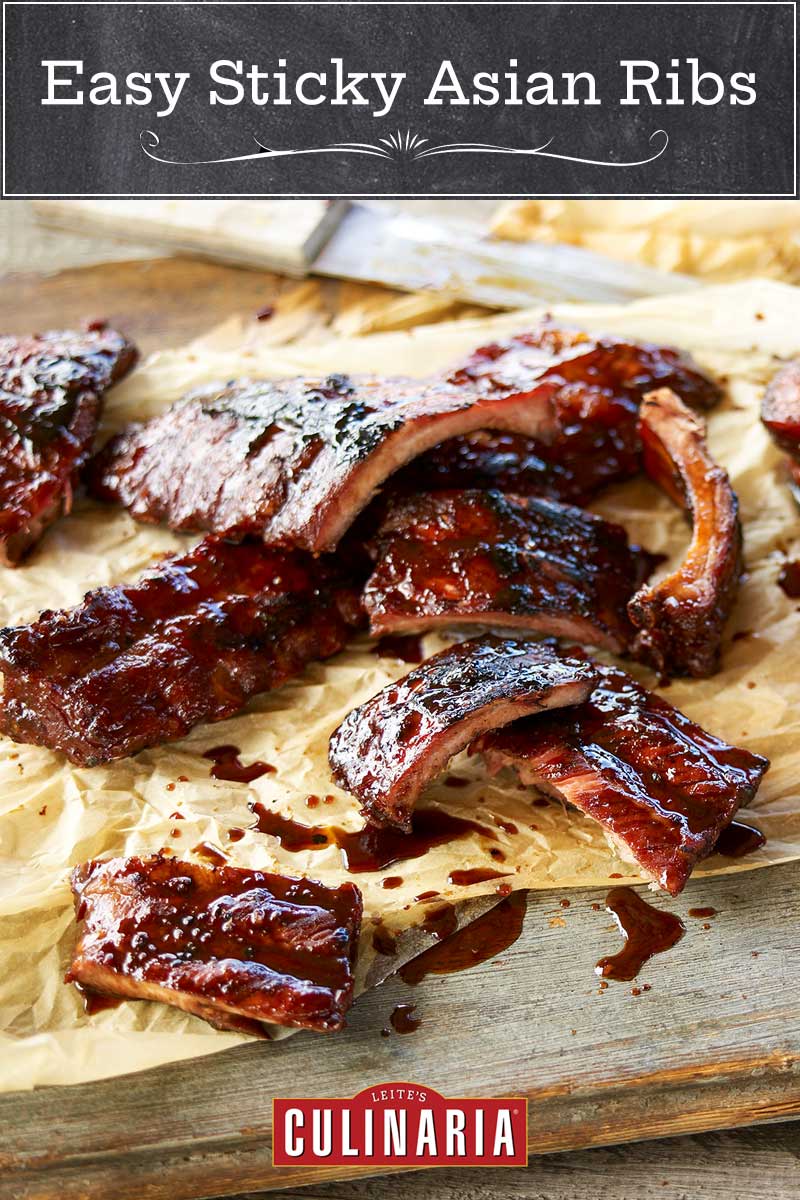
This is a wonderful way to serve ribs at your next barbecue–it has the sweet and sour flavors that work so well with pork. The sweetness comes from maple syrup and sweet soy sauce, and the sourness comes from Chinese black vinegar [Editor’s Note: Not familiar with Chinese black vinegar? Not to worry. See the LC Note below.] The great thing about this dish is that you can prepare everything the day before, which means you also derive maximum flavor from the marinade, which works just as well with chicken drumsticks or wings.–Pete Evans
What are Kecap Manis, Tamarind, and Chinese Black Vinegar?
This Asian-style slathering sauce draws on ingredients that aren’t exactly pantry items for some of us–that is unless you frequent Chinatown–and we make no apology for that. The resulting ribs, having been grilled low and slow until tender, are well worth the time it takes to ogle all the lovely ingredients that some of us don’t shop for nearly as often as we’d like. For the uninitiated, we offer a cheat sheet to the shopping list you’ll need:
Kecap manis is a sweet, thick, syrupy Indonesian soy sauce of sorts. It approximates ketchup in consistency. To make your own ad hoc version, gently simmer equal parts soy sauce and brown sugar or molasses until the sugar dissolves.
Want to save this?
Tamarind is derived from the pod of the tamarind tree and lends an eye-twitchingly tart note to marinades and sauces. You’ll find the concentrate in tubs or jars. You can instead purchase a block of tamarind paste, which looks like–and is–essentially a mass of pods mushed together and make your own concentrate by pouring a little boiling water over a chunk of the block, stirring and mashing it with a wooden spoon until it’s the consistency of a very thick soup, and then straining it several times. It should have the viscosity of something between a paste and kecap manis (or ketchup). You’ll need to fiddle around with the proportions. Best to start with too little water than too much.
Chinese black vinegar is an inky black, aged vinegar made from grains. It has a complex taste, similar to balsamic vinegar. (You can rely on balsamic as a substitute when you’re in a pinch.)

Sticky Pork Ribs
Ingredients
- 1 cup maple syrup
- 1 cup kecap manis, (sweet soy sauce; see LC Note above)
- 1 tablespoon tamarind concentrate, (see LC Note above)
- 4 tablespoons oyster sauce
- 1 1/4 cups Chinese black vinegar, (see LC Note above)
- 2 cinnamon sticks
- 3 star anise
- 4 1/2 pounds pork ribs, (you can use spareribs or babyback ribs), membranes removed* (see * Note)
Instructions
- Combine all the ingredients except the ribs in a nonreactive bowl and stir well. Place the ribs in a large container (a glass baking dish or nonreactive roasting pan will do nicely), dump the marinade over the top, and turn the ribs to coat. Cover and refrigerate at least overnight and up to 18 hours.
- Set up an outdoor grill for indirect-heat cooking over medium-low heat, leaving half of the fire bed free of coals.
- Remove the ribs from the marinade and place them in a heavy flameproof roasting pan. Reserve the marinade. Cover the pan of ribs with aluminum foil and place it on the cool part of the grill. Close the lid on the grill and let the ribs cook for 30 minutes. Carefully uncover the pan of ribs (don’t put your nose too close to the pan in anticipation—trust us), turn them, and brush them with some of the reserved marinade. Recover the pan, close the lid on the grill, and cook the ribs for another 30 minutes or so, until the ribs are caramelized and lightly charred and tender as can be.
- Meanwhile, discard the remaining marinade or transfer it to a small pan, simmer gently until thickened slightly, and pass it on the side for at-the-table slathering. Pile the ribs on a platter or onto a sheet of parchment paper placed on an outdoor table. Dig in.
Notes
*How to remove the membrane from ribs
To remove the membrane or silver skin from a rib, use the tip of a small knife to loosen a corner and then grab the membrane with a paper towel and slowly pull it off.
Explore More with AI
Nutrition
Nutrition information is automatically calculated, so should only be used as an approximation.
Recipe Testers’ Reviews
We love these ribs. They are a great departure from traditional barbecued ribs. The ribs definitely “fall off the bone” and the flavors are delicious–tangy, sweet, almost exotic, and certainly unique. Most of the Asian ingredients are fairly easy to find in a supermarket, but a trip to a specialty market may be needed for a few of them. I used a combination of rice and balsamic vinegar in place of the Chinese black vinegar.
The marinade was quite liquidy. That was fine for marinating overnight, but I found that it didn’t adhere very well when I tried to brush it on the ribs. I then reduced it a bit and it worked fine. Since you’re using indirect heat on a grill, which more or less simulates an oven environment, you could make these ribs in an oven just as easily. You might lose a bit of the smoky flavor you’d get from a grill, but these ribs are so flavorful, I don’t think there would be much of a difference in the overall wonderful result.
Maple syrup and tamarind are just two of the unlikely flavors that constitute the savory, sweet, sticky sauce that coats these tasty ribs. I got baby back ribs and asked my butcher to cut them cross-rib up the middle into two separate racks of mini-ribs. Once home, I carefully separated the rib portions with a sharp knife. This added about five to ten minutes to my preparation time.
Your results may vary, but the ribs weren’t quite ready after an hour. If this happens to you, just remove the foil and keep an eye on them to prevent scorching until you get the right color.













Looks great. Just to be sure, you only need to cook this for one hour? I just wanted to be sure since my experience with babybacks has been at least 2 1/2 to 3 hours of cook time.
Alan, that’s a terrific question. I, too, am used to cooking ribs low and slow, but typically at a much lower temperature than is achieved on a grill. I usually roast them in the oven at 250° to 275°F although of course friends and folks I know tend to do it on a smoker, which usually runs at a much lower temperature than a grill. And you’re right, it’s typically that long, slow heat that slowly coaxes everything to tenderness. We found that just over an hour was enough at this temperature to cook the ribs till doneness, although that’s partly designed to keep the sugars in the marinade from scorching from prolonged exposure to heat. Think of it more as a weeknight rib fix. You could take this and instead try to get your grill to a superlow indirect heat and cook them for 3 or so hours, though of course that’s going to take more tending to keep the temperature right (although it sounds like that’s nothing new to you!) and a watchful eye to keep the residue from the marinade from charring too much. I hope this helps…
I made this for guests (along with a beautiful grilled salmon because I thought some of the group would not go for ribs). Boy, was I wrong! Once people started oohing and aahing as they ate, all of the ribs flew onto plates and into happy stomachs. I was able to find all of the ingredients as specified in the recipe, but I do think balsamic vinegar would work beautifully here. I might increase the maple syrup just a bit the next time, because I like a sweet glaze. I marinated the ribs for 16 hours and would do the same next time. I reduced a portion of the marinade to thicken it up a bit and used that as the final glaze on the ribs. Delicious!
Laughs. I have had that fear, too, Marissa, and quickly been disabused of it! Ribs, especially these sticky pork ribs, tend to have a magical effect on people. Glad they worked their charms for you!